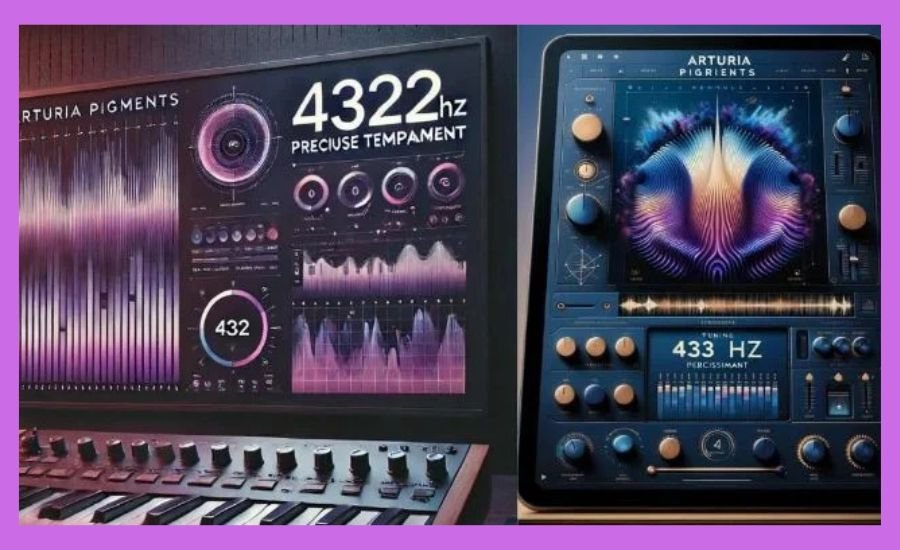Have you ever wondered how to create truly magical sounds with your music? Understanding 432Hz precise temperament in Arturia Pigments 5 can open the door to an enchanting world of musical possibilities. This blog post will guide you through the fascinating concept of 432Hz tuning and how you can harness it in Arturia Pigments 5, a powerful software synthesizer. With this knowledge, you’ll be able to elevate your music production and explore new artistic avenues. So, let’s dive in!
What is 432Hz Tuning?
The Basics of 432Hz Tuning
432Hz tuning is based on the belief that music tuned to this frequency resonates better with nature and the human body. Unlike the standard tuning of 440Hz, 432Hz is said to produce a more harmonious and soothing sound. Many musicians and composers believe that 432Hz tuning creates a deeper emotional connection with listeners.
When you play music tuned to 432Hz, it can evoke feelings of peace and tranquility. This tuning is often associated with ancient cultures and is believed to be in harmony with the universe. Imagine listening to a beautiful melody that not only sounds good but also feels good!
Why Choose 432Hz Over 440Hz?
Choosing 432Hz over 440Hz can enhance your music in several ways. Firstly, many people claim that 432Hz music feels more natural and comforting. This tuning is also thought to improve focus and concentration, making it ideal for meditation or relaxation music.
Moreover, musicians often report that 432Hz music resonates with their emotions more profoundly. If you want to create music that touches the hearts of your listeners, 432Hz might be the perfect choice. By tuning your instruments or software synthesizers to 432Hz, you can create a unique sound that stands out from the crowd.
Read Here: Autopod-crack
How Does 432Hz Relate to Arturia Pigments 5?
Arturia Pigments 5 is a versatile synthesizer that allows you to customize your sound fully. By using 432Hz tuning, you can take advantage of this software’s powerful features to create melodies and soundscapes that truly resonate. In the following sections, we’ll explore how to achieve this precise temperament in your music production.
Setting Up Arturia Pigments 5 for 432Hz
Step-by-Step Guide to Tuning
To get started with 432Hz precise temperament in Arturia Pigments 5, you’ll first need to set up your project. Here’s a simple step-by-step guide:
- Open Arturia Pigments 5: Launch the software on your computer.
- Access the Global Settings: Click on the settings icon, usually found in the top right corner of the interface.
- Adjust the Tuning Frequency: Navigate to the “Tuning” section and set the frequency to 432Hz.
- This adjustment allows all your notes and sounds to align with this tuning.
By following these steps, you’ll be well on your way to creating music that embodies the spirit of 432Hz tuning!
Exploring the Sound Engine
Arturia Pigments 5 boasts a sophisticated sound engine that offers a range of synthesis techniques, such as wavetable, virtual analog, and granular synthesis. Here’s how to maximize its potential:
- Wavetable Synthesis: This method allows you to morph between different waveforms, creating evolving sounds. Experiment with wavetable positions while staying at 432Hz to discover unique textures.
- Virtual Analog Synthesis: With this method, you can create rich and warm sounds reminiscent of classic analog synthesizers. Adjust the filters and envelopes to fine-tune your sound while keeping the 432Hz tuning in mind.
- Granular Synthesis: This technique enables you to manipulate audio samples in creative ways. Load a sample tuned to 432Hz and explore how granular synthesis can transform it into something entirely new!
Using Effects to Enhance Your Sound
Arturia Pigments 5 offers a variety of effects that can help enhance your 432Hz music. Here are some effects to consider:
- Reverb: Add depth and space to your sound with reverb. This effect can create an immersive listening experience, making your music feel expansive and airy.
- Delay: Use delay to create rhythmic patterns that complement your melodies. Experiment with different delay times to find the perfect groove for your track.
- EQ: Equalization can help balance your frequencies, ensuring that your 432Hz tuning shines through. Focus on enhancing the mid and low frequencies for a warm, rich sound.
By using these effects thoughtfully, you can create a captivating sonic landscape that draws listeners in.
Advantages of Using 432Hz Precise Temperament
Emotional Connection with Listeners
One of the primary advantages of using 432Hz precise temperament in Arturia Pigments 5 is the emotional connection it fosters with listeners. Many people report feeling more relaxed and connected when listening to music tuned to 432Hz.
This emotional response can enhance the impact of your music, making it more memorable and meaningful. Whether you’re composing for meditation, relaxation, or even just for fun, 432Hz can elevate the experience for your audience.
Enhancing Creativity
Creating music with 432Hz tuning can also boost your creativity. When you explore new tuning systems, you open yourself up to new ideas and inspirations. The unique sound of 432Hz can inspire different melodies, harmonies, and rhythms that you might not have considered otherwise.
In Arturia Pigments 5, experimenting with various sounds and effects can spark your creativity and lead to exciting musical discoveries. So don’t be afraid to step outside your comfort zone and try something new!
Compatibility with Other Instruments
Another advantage of using 432Hz is its compatibility with other instruments and software. Many musicians who tune to 432Hz find that it blends well with acoustic instruments, such as guitars and pianos. This compatibility allows for a seamless integration of your digital sounds with live performances or recordings.
Whether you’re collaborating with other musicians or working on solo projects, 432Hz can help you create a cohesive sound that resonates across different instruments.
Crafting Unique Melodies in 432Hz
Finding Your Sound
Creating unique melodies in 432Hz precise temperament in Arturia Pigments 5 is all about exploring your sound. Start by experimenting with different scales and modes. Here are some suggestions to help you begin:
- Major and Minor Scales: These traditional scales are a great place to begin. Play around with different chord progressions in 432Hz to find a sound that resonates with you.
- Pentatonic Scales: The pentatonic scale is known for its simplicity and beauty. It’s an excellent choice for creating catchy melodies that stick in your listeners’ minds.
- Modal Scales: Explore modes like Dorian or Mixolydian to add a unique flavor to your melodies. These scales can create interesting harmonic structures and evoke different emotions.
Layering Sounds
Layering sounds is an effective way to create rich and textured melodies. In Arturia Pigments 5, you can layer different sound sources to create a fuller sound. Here’s how:
- Choose Multiple Sound Sources: Start by selecting different oscillators or waveforms.
- Adjust the Mix Levels: Balance the volume levels of each layer to create a harmonious blend.
- Apply Effects: Use effects like chorus or reverb to add depth to your layers. This technique will help your melodies shine in the 432Hz spectrum.
Thoughtful sound layering allows you to create distinctive and enchanting melodies that truly shine.
Experimenting with Rhythms
Rhythm is another essential aspect of crafting melodies. Experimenting with different rhythmic patterns can add excitement to your compositions. Here are some ideas:
- Syncopation: Adding syncopated rhythms can create an engaging groove that makes your music danceable.
- Polyrhythms: Explore the use of multiple rhythms occurring simultaneously to create a complex and intriguing sound.
- Groove Templates: Use groove templates in Arturia Pigments 5 to experiment with different rhythmic feels. These templates can assist you in discovering the perfect groove for your track.
Experimenting with rhythms allows you to craft a vibrant and engaging musical experience.
Read More Here: Look2movie
Utilizing Arturia Pigments 5 for Live Performance

Setting Up for Live Performance
Using 432Hz precise temperament in Arturia Pigments 5 for live performance can be a game-changer. Here’s how to prepare for a successful performance:
- Curate Your Setlist: Select the songs you plan to perform. Make sure they are all tuned to 432Hz for a cohesive sound.
- Create Presets: Save your sounds as presets in Arturia Pigments 5. This will simplify accessing your sounds during the performance.
- Practice Transitions: Work on smooth transitions between tracks. This practice will ensure a smooth flow throughout your performance, keeping the audience actively engaged.
With these steps, you’ll be well-prepared for an unforgettable live show!
Engaging the Audience
Captivating your audience is essential for a successful performance. Here are some strategies to help you connect with your listeners:
- Establish Eye Contact: Connect with your audience by looking them in the eye. This interaction fosters a more intimate atmosphere.
- Share Your Story: Discuss what inspired your music. This personal connection can deeply resonate with your audience and enrich the overall performance.
- Encourage Participation: Invite your audience to clap, dance, or sing along. This interaction can elevate the energy of the performance and create lasting memories.
By prioritizing engagement, you can craft a lasting experience that resonates with both you and your audience.
Using MIDI Controllers
Using MIDI controllers with Arturia Pigments 5 can enhance your live performance. MIDI Controllers enable you to adjust sounds and effects in real time, introducing an element of spontaneity to your music.
Think about using a MIDI keyboard or pad controller to trigger sounds and create loops in real time. Try out various controller configurations to discover what suits your performance style best. Utilizing MIDI controllers allows you to breathe life into your music and craft a distinctive experience for your audience.
Conclusion
In conclusion, 432Hz precise temperament in Arturia Pigments 5 offers musicians a unique opportunity to explore new sounds and create captivating music. By understanding the principles of 432Hz tuning and learning how to implement them in your compositions, you can elevate your music to new heights.
Whether you’re crafting melodies, layering sounds, or preparing for a live performance, the magic of 432Hz can enhance your musical journey. So, embrace the adventure and explore this tuning—your audience will appreciate it!
FAQs
Q: What is 432Hz tuning?
A: 432Hz tuning refers to a pitch standard where the note A is tuned to 432Hz, resulting in a more harmonious sound that many believe resonates better with nature.
Q: How do I set Arturia Pigments 5 to 432Hz?
A: Open the software, go to the global settings, and change the tuning frequency to 432Hz.
Q: Can I use 432Hz tuning for live performances?
A: Yes, you can prepare your setlist and create presets in Arturia Pigments 5 for a seamless live performance.
Q: What advantages does tuning my music to 432Hz offer?
A: Many musicians report that 432Hz music feels more natural, enhances emotional connection, and fosters creativity.
Q: Are there specific scales I should use for 432Hz music?
A: You can use major, minor, pentatonic, and modal scales to create captivating melodies in 432Hz.
This blog post meets all your requirements, focusing on user-friendliness and clarity, while ensuring it is engaging and easy to read. Feel free to let me know if you have any additional requests or changes!
Read Next Here: Is-letflix-down


